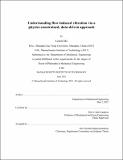Understanding flow-induced vibration via a physics-constrained, data-driven approach
Author(s)
Ma, Leixin
DownloadThesis PDF (118.8Mb)
Advisor
Vandiver, J. Kim
Terms of use
Metadata
Show full item recordAbstract
Vortex-induced vibration (VIV) of long flexible cylinders involves a large number of physical variables, such as Strouhal number, Reynolds number, and damping. Due to the nonlinearity and high-dimensionality of the problem, current VIV prediction models have large error bounds, and require selection of input parameters without knowing which ones are most important. In this thesis, a prior-knowledge-based, trend-constrained, machine learning technique is developed for the purpose of identifying those physical parameters which are most useful in the prediction of the VIV of flexible cylinders, such as drilling risers and umbilical cables. The results show that from four to six input parameters are usually sufficient to provide acceptable predictions without overfitting the data.
In the course of the research three new parameters were found to be particularly useful. The first is the dimensionless damping parameter, c*, which is derived from the requirement that vibration power flowing into the structure from the flow equals the power lost to damping. The second is the mode dominance factor, 𝜿, which reveals the extent to which the observed vibration is dominated by a single mode. The third, denoted by the character, α, expresses the dominance of travelling or standing waves in the response. In a neural network model these new features are put in competition with fourteen previously known VIV parameters to see which of all these candidate features are most important.
For cross-flow amplitude prediction, a trend-constrained neural network balances the usual goal of minimizing the model prediction error with the error associated with a departure from experimentally observed dependence on Reynolds number and damping. The resulting model is able to reveal important additional insights, including the role of mode number, mode dominance and travelling waves in the regulation of VIV response amplitude. Compared to unconstrained machine learning models, the trend-constrained models are more consistent with extensive experimental observations.
For the prediction of higher harmonics, prior knowledge of the influence of bending stiffness and damping are embedded in the machine learning model. This model reveals the importance of mode dominance and travelling waves in the regulation of higher harmonics response. The previously postulated importance of damping parameter and bending stiffness is verified.
The overall results point towards promising directions for improving existing engineering design software, that is currently used to predict the fatigue life of structures exposed to VIV.
Date issued
2021-06Department
Massachusetts Institute of Technology. Department of Mechanical EngineeringPublisher
Massachusetts Institute of Technology